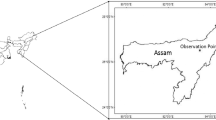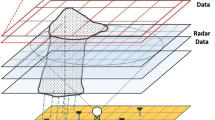Abstract
Temporal disaggregation of rainfall data is an important topic of research due to the lack of good quality high temporal resolution data for several regions and locations. Long sequences of high-resolution rainfall data is extremely valuable for various purposes in water resource engineering, especially in urban hydrology. Several methods of disaggregation have been studied worldwide to convert low temporal resolution rainfall data to a higher temporal resolution to generate rainfall data with a reliable degree of statistical accuracy. Artificial neural network (ANN) is a machine learning model which is currently being widely utilised in several different fields due to its wide adaptability and versatility in modelling different physical phenomena. However, its application in the disaggregation of rainfall data from daily to hourly temporal levels has not been extensively tested, especially in a monsoon-based rainfall system like the Indian monsoon climate. This paper studies the feasibility of a deep learning ANN in the Indian monsoon system while combining it with a K-means clustering algorithm for the purpose of disaggregation. The results show that the model can effectively conserve hourly rainfall statistics while also capturing extreme rainfall characteristics post disaggregation. This is seen in its ability to conserve the hourly mean and the number of dry hours while being able to generate Intensity–Duration–Frequency (IDF) curves which closely resemble the IDF curves generated from the observed data. The model can generate values at high temporal resolutions of up to 1-h durations using daily rainfall inputs which may be aggregated to different temporal aggregation levels.












Similar content being viewed by others
References
Abadi M, Agarwal A, Barham P, Brevdo E, Chen Z, Citro C, Corrado G, et al. (2015) TensorFlow: large-scale machine learning on heterogeneous systems. Software available from tensorflow.org.
Aziz K, Rahman A, Fang G et al (2014) Application of artificial neural networks in regional flood frequency analysis: a case study for Australia. Stoch Environ Res Risk Assess 28:541–554. https://doi.org/10.1007/s00477-013-0771-5
Burian SJ, Durrans SR, Tomić S, Pimmel RL, Wai CN (2000) Rainfall disaggregation using artificial neural networks. J Hydrol Eng 5(3):299–307. https://doi.org/10.1061/(asce)1084-0699(2000)5:3(299)
Burian S, Durrans S, Stephan N, Robert P (2001) Training artificial neural networks to perform rainfall disaggregation. J Hydrol Eng. https://doi.org/10.1061/(ASCE)1084-0699(2001)6:1(43)
Clevert D-A, Unterthiner T, Hochreiter S (2015) Fast and accurate deep network learning by exponential linear units (ELUs). arXiv. https://doi.org/10.48550/ARXIV.1511.07289
Gupta V, Waymire E (1990) Multiscaling properties of spatial rainfall and river flow distributions. J Geophys Res 95:1999–2009. https://doi.org/10.1029/JD095iD03p01999
Khaliq M, Cunnane C (1996) Modelling point rainfall occurrences with the modified Bartlett–Lewis rectangular pulses model. J Hydrol 180(1–4):109–138. https://doi.org/10.1016/0022-1694(95)02894-3
Koutsoyiannis D, Xanthopoulos T (1990) A dynamic model for short-scale rainfall disaggregation. Hydrol Sci J 35(3):303–322. https://doi.org/10.1080/02626669009492431
McQueen J (1967) Some methods for classification and analysis of multivariate observations. Comput Chem 4:257–272
Mosteller F, Tukey JW (1968) Data analysis, including statistics. In: Lindzey G, Aronson E (eds) Handbook of social psychology, vol 2. Addison-Wesley
Nourani V, Farboudfam N (2019) Rainfall time series disaggregation in mountainous regions using hybrid wavelet-artificial intelligence methods. Environ Res 168:306–318. https://doi.org/10.1016/j.envres.2018.10.012
Olsson J (1998) Evaluation of a scaling cascade model for temporal rain- fall disaggregation. Hydrol Earth Syst Sci 2:19–30. https://doi.org/10.5194/hess-2-19-1998
Onof C, Wheater HS (1994) Improvements to the modelling of British rainfall using a modified random parameter Bartlett-Lewis rectangular pulse model. J Hydrol 157(1–4):177–195. https://doi.org/10.1016/0022-1694(94)90104-x
Onof C, Chandler R, Kakou A et al (2000) Rainfall modelling using Poisson-cluster processes: a review of developments. Stoch Environ Res Risk Assess 14:384–411. https://doi.org/10.1007/s004770000043
Poomalai S, Chandrasekaran S (2019) Disaggregation of rainfall time series using artificial neural network in case of limited data. Int J Eng Adv Tech (IJEAT). https://doi.org/10.35940/ijeat.A1005.1291S41
Riad S, Mania J, Bouchaou L, Najjar Y (2004) Rainfall-runoff model using an artificial neural network approach. Math Comput Modell 40 (7–8):839–846, https://www.sciencedirect.com/science/article/pii/S0895717704002742
Rodriguez-Iturbe I, Roxbee C, Valerie I (1987) Some models for rainfall based on stochastic point processes. Proc R Soc Lond A 410:269–288. https://doi.org/10.1098/rspa.1987.0039
Rodriguez-Iturbe I, Roxbee C, Valerie I (1988) A point process model for rainfall: further developments. Proc R Soc Lond A 417:283–298. https://doi.org/10.1098/rspa.1988.0061
Rousseeuw PJ (1987) Silhouettes: a graphical aid to the interpretation and validation of cluster analysis. J Comput Appl Math, 20:53–65. https://doi.org/10.1016/0377-0427(87)90125-7
Rumelhart D, Hinton G, Williams R (1986) Learning representations by back-propagating errors. Nature 323:533–536. https://doi.org/10.1038/323533a0
Schertzer D, Lovejoy S (1987) Physical modelling and analysis of rain and clouds by anisotropic scaling multiplicative processes. J Geophys Res 92(D8):9693–9714
Segond ML, Onof C, Wheater H (2006) Spatial–temporal disaggregation of daily rainfall from a generalized linear model. J Hydrol 331(3–4):674–689. https://doi.org/10.1016/j.jhydrol.2006.06.019
Singh P, Borah B (2013) Indian summer monsoon rainfall prediction using artificial neural network. Stoch Environ Res Risk Assess 27:1585–1599. https://doi.org/10.1007/s00477-013-0695-0
Thirumalaiah K, Deo MC (2000) Hydrological forecasting using neural networks. J Hydrol Eng 5(2):180–189. https://doi.org/10.1061/(asce)1084-0699(2000)5:2(180)
Valencia D, Schaake JC (1972) A disaggregation model for time series analysis and synthesis. Ανακτήθηκε από https://books.google.co.in/books?id=Ir3gGAAACAAJ
Valiant L (1984) A theory of the learnable. Commun ACM 27(11):1134–1142. https://doi.org/10.1145/1968.1972
Vandenberghe S, Verhoest NEC, Onof C, De Baets B (2011) A comparative copula-based bivariate frequency analysis of observed and simulated storm events: a case study on Bartlett–Lewis modelled rainfall. Water Resour Res 47:W07529. https://doi.org/10.1029/2009WR008388
Acknowledgements
We acknowledge the research infrastructure provided by the Civil Engineering Department, Indian Institute of Engineering Science and Technology (IIEST), Shibpur.
Funding
The authors declare that no funds, grants, or other support were received during the preparation of this manuscript.
Author information
Authors and Affiliations
Contributions
All authors contributed to the study, conception and design. Methodology, software, writing-original draft was performed by DB. Supervision, data acquisition, writing- review and editing were performed by Dr. US.
Corresponding author
Ethics declarations
Conflict of interest
The authors have no relevant financial or non-financial interests to disclose.
Additional information
Publisher's Note
Springer Nature remains neutral with regard to jurisdictional claims in published maps and institutional affiliations.
Rights and permissions
Springer Nature or its licensor (e.g. a society or other partner) holds exclusive rights to this article under a publishing agreement with the author(s) or other rightsholder(s); author self-archiving of the accepted manuscript version of this article is solely governed by the terms of such publishing agreement and applicable law.
About this article
Cite this article
Bhattacharyya, D., Saha, U. Deep learning application for disaggregation of rainfall with emphasis on preservation of extreme rainfall characteristics for Indian monsoon conditions. Stoch Environ Res Risk Assess 37, 1021–1038 (2023). https://doi.org/10.1007/s00477-022-02331-x
Accepted:
Published:
Issue Date:
DOI: https://doi.org/10.1007/s00477-022-02331-x




